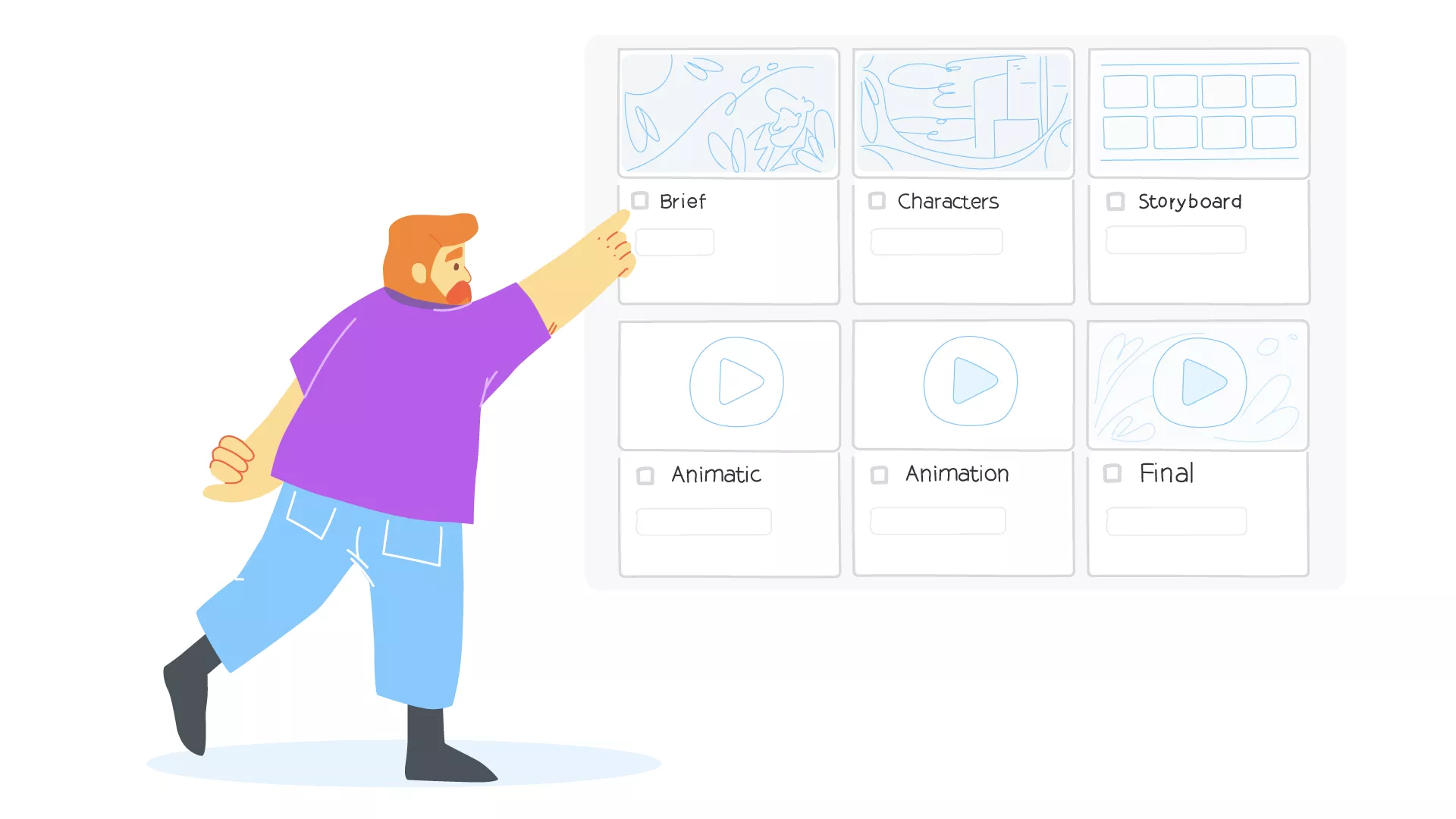When it comes to relationships with clients, it’s important to have a strong line of communication that strays from confusion and heads toward clarity. One of the best ways to get clients on the same page as employees are by writing a creative client brief.
However, where does one start? We talked with Emily Spicer, a Senior Producer at Scriberia.
What is a Creative Brief?
So, what’s a creative brief?
In essence, a creative client brief is your roadmap to navigating a project between two teams. The client will create the brief to send to the agency working on their creative endeavor. It lays out everything the agency needs to know. It also makes sure that both the client and the innovative team are on the same page.
The briefing process is a chance for everyone to get on the same page and is key to setting expectations.
They will describe their overall brand, and how past projects have gone. And, also, what they want from the relationship with the creative agency.
It’s a space for the client to share what they want to get out of the project – their goals and aspirations.
You can create the brief through any means that ultimately relay the message in the best possible way.
Emily goes on to say that “sometimes this can be verbal or written. For us, a written brief ensures that all the key deliverables are clear. This, followed by a call to add context and a sense story, is ideal.
When the team has a brief, they can consistently check back in on what the client wanted throughout the process.

For a client brief, and any other form of communication, cooperation from both parties are crucial. The client creates their brief.
However, the agency may supply a guideline document to help the client describe their situation effectively. This also allows the agency to make sure they receive all the information they need.
The Essential Elements of a Creative Client Brief
Every client brief will look a little different depending on the agency you’re working for and the client you are. Different clients require different requirements in the briefs they write.
It really depends on the service or product and the approach – for live event briefs, the sections on logistics are really key, and those sections differ for virtual or on-site events. In the same breath, briefs, where artwork is created from a recorded virtual event, wouldn’t need any of these sections at all. – Emily explained
The type of briefing template varies and should vary to suit the needs of various creative clients. However, a few essential elements stay the same no matter what.
Emily explains:
The main elements that all of our briefs would ask for would be the purpose, the key content needed to be communicated, the requirements of the deliverables – size/spec/orientation/branding/deadlines and any expectations for look and feel.
Let’s break those necessities down.

The purpose encapsulates what your brand does and what the agency can do to further your brand. Here, you can give some background on your brand, such as what you do, where you started, your core functions, and your business timeline.
The key content needed, that the agency should communicate, is the most vital part of any client brief. This is the information that is essential for the agency to understand. What do you think is necessary for them to know? The more, the better.
The requirements of the deliverables are the little details and expectations that you have.
Like Emily said earlier, the client brief should include all the deadlines. So that all the stakeholders agree on them from the very beginning. Also, the details for your final project and what you expect it to be should be road mapped out from the start.
With these essential elements, your task is sure to start out on the right foot. Any other information needed will depend on the agency and the type of product you offer.
Navigating Difficulties When Writing a Brief
The goal when writing a brief is to have clear communication from the start. However, this can be more difficult to accomplish depending on the type of client.

Every company will have its own culture and approach, affecting how its people communicate. And this is also true of different industries – pharmaceutical communications agencies work in a very different way to brand communication agencies, for example.
No matter who you are working with, barriers will often get in the way when learning to communicate with a new team.
In many (if not all) cases, using the right tools for communication between the client and team is the key to success. Here, one should have a look at the available online proofing platforms. These allow gathering all the feedback, both from the client and the team, in one space.
Teams should give preference to the tools with the visual feedback functionality, as it helps to lay out the ideas and vision for the final result.
Check out these comparison charts with the most widely used online proofing tools.
Looking in the Same Direction
Another thing to remember is “to approach every project from a human perspective, never assume that what is obvious to you is obvious to someone else.” Your teammates may understand you even when you communicate poorly. That’s a luxury that comes with time.
However, when working with a new team, learning and altering your communication style is very important. It can help you get your point across and align your mission with the agency.
Emily emphasizes to not “be scared to look stupid and ask questions. Be patient and kind. Remember that everyone wants the same result – a great output and an enjoyable time making it.”
No matter what happens in terms of difficulties, remembering that all parties are looking to create a great product can result in just that, a fantastic piece of work.
Different Styles for Different People

Depending on the agency and the client, different styles of briefs will be needed. Whatever your type of communication is, try to blend it with the team you’re working with to have the most cohesive explanation.
Whether a brief should be detailed and scrupulous or allow for complete creative freedom largely depends on the person. Emily says that “personally, I’m all about the detail, but I’ve seen some of the best work happen when complete creative freedom is given.”
It truly depends on where you thrive and what method blends communication between parties well.
The best briefs are a balance of both – when the key elements are super detailed – knowing exactly what format, what size, how many versions, etc., alongside a big open theme or question. Knowing what the big picture needs to say and how you want people to feel is what’s most important, then let your artist do their magic.
Getting too detail-oriented can strip creativity and freedom from the agency. Still, not enough direction, and the project you initially anticipated will never come to life in the way you wanted.
The Ideal Client Brief
So, what is the perfect client brief?
The perfect client brief leaves enough room for creativity while setting the perfect boundaries within which to be creative.
Don’t be afraid to list out everything you want from the project in your brief. However, remember that too strict confines can make the agency feel trapped and unable to do their best work. It’s a delicate balance.
As Emily points out:
A brief shouldn’t tell someone how to approach the project – it should give them all the tools they need to understand the problem and find the solution. The perfect brief will offer enough information & flexibility so that everyone can be clear on what can be achieved for the agreed time and budget.
Think of it as a science experiment. You don’t need to have the answer right away, but you need the tools and controls to set it up. From there, it’s a matter of blending creativity, reconstructing ideas, and communicating in a way that everyone can understand.
Communication is Key

In and out of business, communication is vital to sustaining healthy relationships. And client briefs start business communications off on the right foot.
So what is the fastest and easiest way to discuss the brief with the client? And what would be the most effective technique to brainstorm on it with the team?
An online proofing software with visual feedback feature! Where all the stakeholders, can share their revisions and opinions. Preferably, all the feedback should be stored in a single space. Krock.io provides this functionality, along with many others that allow you to:
- discuss the details of the brief both with the client and the team
- leave visual notes, so that the feedback is the most comprehensive
- have all the feedback in one place, well structured, and time-coded
Besides online proofing, Krock.io provides all the necessary features to manage your creative project from start to finish:
- separate workspaces for different clients
- Gantt charts and calendar
- versioning
- different step types for your production pipeline: for documents, such as briefs, images, videos, and storyboards.
- sending your work for review directly from the platform
- Google Drive, Zoom, and Slack integration
and many more.

You can always try Krock.io for free with the 2-week trial. Or book a short demo call and get familiar with all features together with our team.
Conclusion
Using the right communication tools keeps the relationship between your team and client cohesive. And it provides an understanding throughout your project. Client briefs vary, but one thing is clear, nothing can be achieved when communication is lacking.
FAQs
1. What is a creative brief?
In essence, a creative client brief is your roadmap to navigating a project between two teams. The client will create the brief to send to the agency working on their creative endeavor. It lays out everything the agency needs to know. It also makes sure that both the client and the innovative team are on the same page.
2. What should be in a creative client brief?
- The purpose of the project
- The key content needed to be communicated
- The requirements of the deliverables
- Size
- Specs
- Orientation
- Branding
- Deadlines
- Any expectations for the look and feel of the final media
3. What does writing a creative brief entail?
The fastest and easiest way to discuss the brief with the client is to use online proofing software with visual feedback feature. Where all the stakeholders, can share their revisions and opinions. Preferably, all the feedback should be stored in a single space. Krock.io provides this functionality, along with many other features.
4. A perfect creative brief is:
The perfect client brief leaves enough room for creativity while setting the perfect boundaries within which to be creative.
A brief shouldn’t tell someone how to approach the project – it should give them all the tools they need to understand the problem and find the solution. The perfect brief will offer enough information & flexibility so that everyone can be clear on what can be achieved for the agreed time and budget.
